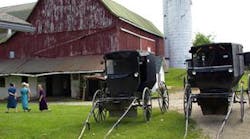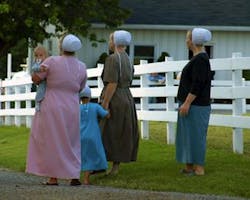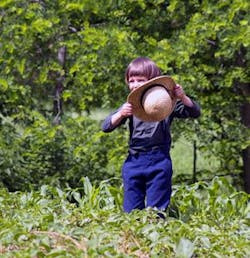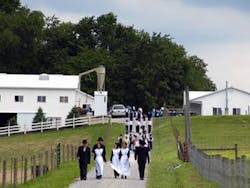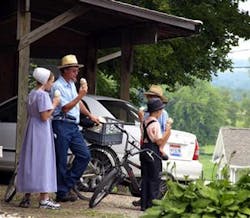"How's the economy doing in Colorado?" asks Roy. I tell him that distances out where we live are vast, that I'm glad the cost of gas has gone down, but still…
Wait. Why am I discussing the costs of driving with an Amish man who isn't allowed to drive a car? I hear myself start to stutter. But Roy is unphased.
"Costs more these days to feed the horses that pull my buggy," he says. "Going places is just getting more and more expensive for everybody."
And with that our differences disappear.
Roy makes belts, which is unusual considering he can't wear one. Like all Amish, he wears buttoned pants held up by suspenders. Zippers are verboten and belts are unnecessary. But the "English," as the Amish call the non-Amish, like them, and he likes designing them. This is quite an admission for an Amish man. It indicates creativity and even a bit of pride. Neither trait is valued amongst a people who respect conformity and put the group above the individual.
The Amish came to America in the early 1700s to escape religious persecution in Switzerland. Now 150,000 are spread through 24 states, although about 80 percent live in Ohio, Indiana and Pennsylvania. Most people associate the Amish with Lancaster County, Pennsylvania (where the 1985 film, Witness, was filmed), but the largest concentration actually lives in central Ohio, in the area of Holmes and the four adjoining counties. That's where Roy has his leather factory.
He returns to the subject of the economy. If current economic conditions translate into fewer tourists walking through his door, he may have to go to mail-order, he says. This presents a problem. Postage costs are up, and the Amish generally don't use computers.
"I could ask an English friend to manage my website," he says. "I don't want to, but we have to adjust." Something in the tone of his voice leads me to suspect that R. W. Leather just might have a website in a few years.
The Amish have survived by adjusting, by walking the thin line between remaining separate and interacting with the larger, English world. Scriptures tell them "Do not be conformed to this world" (Romans 12:2), but modern society tells them that sometimes they must use a car, phone, computer and electricity. They've come up with some interesting solutions to this conundrum.
They refuse to drive a car, but they can ride in one driven by an English. They ban telephones from their homes, but not from a booth in their yards. They don't use electricity, but they can use lights and appliances - including stoves and refrigerators - that are powered by batteries or generators.
Yet their dress and buggies set them apart and make them curiosities to outsiders. Inevitably businesses that purport to explain their lifestyle have sprung up near Amish communities. There are "Amish farms" where folks can tour a "typical Amish house" and restaurants where they can have a "typical Amish meal."
My husband and I weren't interested in visiting tourist attractions, no matter how authentic. We wanted to interact with the people on a one-to-one basis. When LaVonne DeBois, owner of Amish Culture Tours, agreed to drive us around on a private tour through the back roads of Holmes County, we were elated.
LaVonne knows everybody. "Look, there's Louella Miller," she says, stopping her car in front of a stately three-story house with a wrap-around porch. The house is surrounded by a large, well-manicured yard, and except for the clothes hanging on the line out back (no automatic clothes washer and dryer) and the buggy in the driveway out front, it looks like the homes in most well-to-do suburbs.
"Louella and her husband, Morris, are New Order Amish," says LaVonne, noticing my surprised expression. She explains that the Amish range from the ultra-conservative Swartzentrubers, who adhere to the most austere forms of the religion, to the New Order folks who share the same basic beliefs but are more relaxed when it comes to lifestyle.
Louella, who's wearing traditional Amish clothing - a plain gray frock which comes down to her ankles and a white headscarf - also sports a pair of most non-traditional black Crocs. She comes over to say hello. We chat about everyday things - the relatives who are coming to visit, the birdhouses that her husband has put in the yard.
We leave Louella and Morris to their day's work and drive to a Swatzentruber's home, where two sisters, Lovina and Mary, run a small quiltmaking business. Mary is out tending the garden, while her grandson peeks at us from behind his hat. "Land is here and I gotta do something with it," she says. "It's no more work to garden than to mow."
The house is bare-bones simple. No carpet. No overstuffed furniture. A wood-burning stove. It's a far-cry from the lovely home of Louella and Morris. But the quilts – ahh, they're beautiful. Lovina lets us take a photo of the quilts, although she, like all Amish, doesn't want to be photographed herself. The Bible commands that "You shall not make for yourself a graven image (Exodus 20:3-6) and the Amish take this prohibition seriously.
As we head towards a broommaker's house, LaVonne spots a man she knows from the days when she worked as a driver, a person who transports the Amish to and from work. "Hey, John," she calls. "How's your wife doing?" She chats. He chats. Pretty soon we chat too. It's one big happy family. "Any weddings going on today?"
Weddings take place on Tuesdays and Thursdays, LaVonne tells us. That way they don't interfere with church, which is on Sunday, and people can plan around the possibility of a wedding. "Sure enough," says John. "My neighbor's daughter is getting married this afternoon."
We can't go to the ceremony, but we can see the procession - the time when the guests, led by four "witnesses" and the bride and groom, walk from the bride's house, where the wedding was held, to a neighbor's house, where the reception will be held. We watch as some 300 people –– men clad in the traditional dark suit and top hat, women in dark dress and caps - walk from house to house, chatting amiably. The children walk respectfully too. No running. No loud voices.
Later that day we visit the broommaker. He's been blind since birth, but he makes brooms with skilled dexterity. His wife, Clara, comes out to talk. She wants to discuss a recent case of mistaken identity: two girls were in an automobile accident and, in a ghastly mistake, the wrong girl was identified as dead. "I haven't heard what's happened to them since," she says, and I wonder how she expects to hear without radio or television. Yet, Clara's every bit as up on the news as I am. Newspapers, I guess, and grapevine gossip.
Later we have dinner at the home of John and Frannie Yoder. Their home isn't as modern as the Millers' but much more so than the Swatzentruber sisters.
We eat in the kitchen at a wood table covered with a checkered tablecloth. The serving dishes are plastic, the dishes comfortably mis-matched. No fuss, no airs, but plenty of good food. A noodle casserole with a bit of chicken. Green beans. Beets. Homemade bread that John can't eat because, he says, he's prediabetic. Homemade strawberry pie. Tea. Coffee.
The conversation is down-home friendly. We discuss the weather. Neighbors. Children. John, who's a bishop in the church, gets called away to tend to church business. Frannie chatters on. She has perfect skin, red cheeks that looked rouged but aren't. She explains that she was single until six years ago, when church elders asked her to marry John, whose wife had recently died.
"It's strange to think that a person can be so happy single and then so happy married," she says. She discusses the problem of finding someone to stay with John's disabled daughter while she and John go away to a second-marriage get-together. Then she laughs. "I talk too much," she says, "but that's the way I am." We laugh too and assure her that she doesn't talk too much at all. This is neighbor-talk, good-friend talk, and we love every minute.
The day ends too soon. The Amish may wish to remain separate, but our day proves that our lives are more similar than they are different. Cellphones and electricity aren't what's important. Conversations are what connect us, and the Amish are delightfully willing to converse.
For information on Amish Culture Tours, see amishtoursofohio.com or contact owner LaVonne Debois at [email protected] or 330-893-3248.
For a lovely book about the Amish of Holmes County, check out HOLMESPUN: An Intimate Portrait of an Amish and Mennonite Community; photographs by Amanda Lumry and Loren Wengerd; Text by Laura Hurwitz (Eaglemont Press).
In addition to travel writing, Irv and Andrea have founded LEGACY PROSE™, a company that helps people pass on their stories and values to their children and grandchildren www.legacyprose.com
